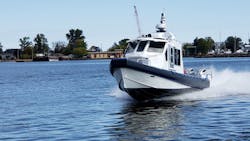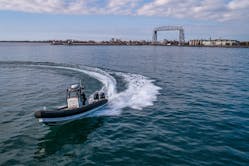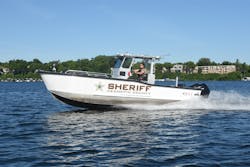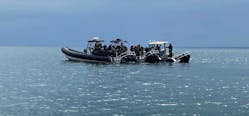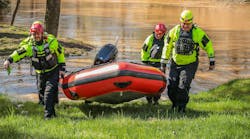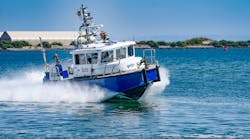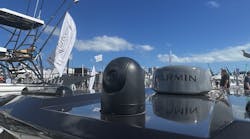As coastlines become more populated across the United States, more law enforcement agencies have either added or expanded their marine patrol units. The extra manpower comes with the need for more training and considerations for equipment and technology.
OFFICER Magazine recently spoke to Capt. Brad Williams (Ret.), Tactial Program Manager for the National Association of State Boating Law Administrators (NASBLA), and Bob Beck, Director of Sales and Marketing for Lake Assault Boats, about the importance of both and how agencies can bolster their assests for patroling waterways.
“Unless you are a boater, you don’t see what’s going on out on the water as far as law enforcement. There’s just a tremendous number of very dedicated law enforcement officers out there that are doing this job in trying and dangerous conditions,” says Williams. “Every time we can sing their praises, that’s a good thing.”
Beck says that Lake Assault tries to keep up witth all of the latest and greatest trends in order to better assist the agencies it serves. “The industry has continued to grasp those things and keep moving forward with them. There are new and unique hull designs and shapes out there that are really being tested and kind of validated.”Training considerations
Williams is a 38-year maritime law enforcement veteran. He first worked for the state of Mississippi before serving with the Florida Marine Patrol, which became the Florida Fish and Wildlife Commission, for a majority of his career. “I developed a passion for training, and that’s what led me to NASBLA. I like the idea of training our officers the correct way rather than them learning it the way I did.”
When Williams began his career in 1979, there weren’t a lot of maritime domain law enforcement entities. Within states, water patrol was mainly handled by game wardens, fish and wildlife and environmental protection agencies. “The increase in coastal populations and the increase in general in recreational aspects of the maritime domain—there are more people out there on boats and using the resource—local agencies have brought officers to bear on the problem by necessity,” he says.
The environment out on the water is much different than that on land for officers, which necessitates the need for added training. “Everybody knows how to do a felony car stop. But next time you do a felony car stop, I want you to pull up next to the bad guy and tie your mirror to his mirror and then do everything you need to do without touching the ground,” says Williams. “That’s our world out in the water. It’s quite different.”
NASBLA’s program covers all 50 states and U.S. territories. Since the program began around 10 years ago, they’ve trained close to 18,000 officers nationwide in various disciplines.
Varying waterways
From lakes to rivers to larger bodies of water like the Gulf of Mexico and the Pacific and Atlantic oceans, there are many variables to take into account when it comes to both training and equipment.
“The variety of the geographics is important,” says Williams. “At NASBLA, we’ve learned to tailor the classes that the agencies take to their areas. It’s not like a school you come to. We send an instructor cadre to a location; we teach on their boats and in their waterways. That’s much more beneficial to them.”
NASBLA has close to 200 credentialled instructors across the country, so there is always someone who has local knowledge of the area NASBLA travels to for training. “That’s how we overcome those differences from agency to agency,” he says.
The boats that agencies operate on also are a big difference from agency to agency. Smaller, single-engine boats are used on lakes and rivers and larger, twin-engine boats—or even boats with three or more engines—are used to patrol the coasts.
“There are different missions,” says Williams. “Your coastal boarder states might be doing more interdiction of narcotics and migrant interdiction. Inland states will have more search and rescue in lakes and rivers.”
The ability for NASBLA to offer a broad catalog of classes is important. “The curriculum we put out is gear toward local areas. There is a certain amount of customization when we go to that place and become familiar with their area of responsibility.”Standardizing training
There has been a coordinated effort to standardize training across the country when it comes to water patrol. When it comes to traditional police academies, what officers are taught from state to state is pretty much the same. That wasn’t the case with training for marine officers until NASBLA partnered with the U.S. Coast Guard about a decade ago to develop training for law enforcement agencies.
NASBLA works closely with the Office of Boat Forces within the U.S. Coast Guard. NASBLA’s Boat Operations and Training program (BOAT) (nasbla.org/BOAT) trains law enforcement agencies across the country to a Coast Guard standard, from tactics to vocabulary. Many of the courses include a FEMA course number so that federal grants can be used to obtain the training.
The goal is to get everybody “singing from the same sheet of music,” says Williams. “If an officer from Kentucky gets sent to Biloxi, Mississippi because of Hurricane Katrina, he can work seamlessly with the onsite Coast Guard and the officers from Florida who came to help. We’ve become a force-multiplier for each other, and that’s an important thing out on the water.”
Williams adds that there can be several different agencies patrolling the same body of water daily and that it is important for everyone to be on the same page. “You need to know everybody on the water who has a blue light, and it really doesn’t matter what it says on the side of the boat,” he says. “It could be anybody out there helping you, so everybody understanding the process and doing things the same makes it much more effective. It’s safer for the community and for the officers.”
The right boat for the job
Lake Assault Boats is a Wisconsin-based manufacturer that specializes in fire boats, rescue boats and patrol boats. “When we talk about the law enforcement market, obviously at Lake Assault, we build fire boats and patrol boats—law enforcement boats. Two separate markets that are very different in some ways but very much the same in other ways,” says Beck. “We’ve really pushed into the law enforcement market in the last handful of years, designing and supplying patrol boats. Within that sector, it really varies from agency to agency, how they do business.”
Some agencies prefer single-person watercraft versus other agencies that have two people or more on their boat crews. He also reiterated that the areas that agencies operate in are vastly different. “We encounter folks who operate on Lake Tahoe, all the way to the open ocean. It just depends on the customer and where they are located.”
When speaking to clients and figuring out the right boat and configuration for a given agency, Beck says that it starts with finding out what their mission is, what they do and where they do it. “It can be vastly different, even across one body of water,” he says. “It really is an individual thing where you’ve got to build that relationship with the customer and then understand what they actually would like to do with their boat.”
A sales cycle can span multiple years and involves back-and-forth communication exploring different models of boats. While Lake Assault offers some basic sized boats and models that fit the basic needs of certain agencies, they also offer customization agencies can take advantage of.
“We work directly with them to identify specific needs that they have,” says Beck. The Hennepin County Sheriff’s Office in Minnesota, for example, just included a fire pump on the boats they recently purchased from Lake Assault. Aside from traditional watercraft, Lake Assault also manufacturers air boats used on the ice for multiple agencies on the Great Lakes.Emerging technology
Williams says that the vast additions in technology have been one of the biggest changes since he began his career. “We have so much more capability on a given platform or patrol boat,” he says. “When I started, it was if you had one boat in the fleet that had radar, you considered yourself very lucky. All the rest of the boats were pleasure boats that had been converted over to patrol. Now, a purpose-built patrol fleet is important. Technology like radar, side-scan sonar, infrared cameras and collision avoidance—all kinds of things that are on our patrol boats—are by default nowadays.”
The ability to have internet and satellite communications on patrol boats has increased the capabilities of patrol crews out on the water. “It’s been a huge assistance to what we do out there,” he says. “When I started in the business, you had a depth finder that would tell you how deep it was, and that was it. Now you’ve got side-scan sonar that gives you a three-dimensional picture of the bottom and it’s pretty amazing. Forward-looking infrared (FLIR) equipment makes it so much safer for the officer out there running at night and so much more effective searching for a missing boater out there at night as well.”
Beck agrees, saying that from electronics to propulsion systems, technology is everchanging. “If you don’t like what you have, wait a minute. Something new will come out next week. Those continue to evolve,” he says. “We try to stay abreast of all those changes and upgrades. Engine technology is constantly changing.”
One advance in the industry is a joystick control system that Lake Assault prototyped for outboard motors. “We were really the first ones that did it in the fire and police markets. That’s become a super-popular option these days. It allows the operator to operate at slower speeds; much easier to maneuver around the dock.” The joystick control system was initially designed for the recreational fishing industry. “It was never designed for what we use it for, but it turned out to be a really great tool,” says Beck.
Crew fatigue is another issue that technology has helped addressed. “The operators of boats spend many, many hours on these things while patrolling or whatever the mission requires,” he says. “They can be on for eight hours, 10 hours on a boat or longer. Crew fatigue is a huge issue that has to be addressed.”
Beck says that one of the things that has helped has been shock mitigation technology. Whether that is crew seating—there are shock-mitigating seats that they use and that reduces the fatigue—or deck matting and a combination of other things such as hull design.
Williams says that as the years have passed, watercraft is now being made specifically for law enforcement, which has made a big difference in how officers do their jobs. “The boats themselves being purpose-built. The differences are it’s built out of aluminum, it’s very robust. It’s got all of the electronics suites; but it also has enhanced safety features like shock-absorbing seats that allow the officers to do things in weather that a pleasure boat wouldn’t dare to go out in and do it more safely.”
